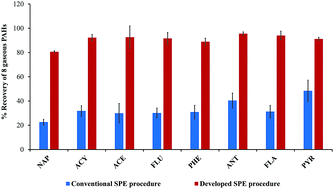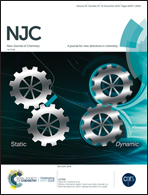Effective solid phase extraction using centrifugation combined with a vacuum-based method for ambient gaseous PAHs
Abstract
Ambient gaseous polycyclic aromatic hydrocarbons (PAHs) are reactive with other compounds and release highly toxic compounds (i.e., diones, nitro-PAHs and dinitro-PAHs). This research aims to develop a simple and cost-effective clean-up procedure for low molecular weight PAHs (i.e. naphthalene, acenaphthylene, acenaphthene, fluorene, phenanthrene, anthracene, fluoranthene, and pyrene). The solid phase extraction (SPE) apparatus was packed with both silica and polymer sorbents that were optimized for extracts obtained from the solvent-extraction technique prior to gas chromatography-mass spectrometry (GC-MS) analysis. A combination of centrifugation, a vacuum-based method (drying step), and low temperatures (elution step) is the highlight of this work. These proposed steps could reduce the time needed for analysis and provide high recovery values (80–96%) of 8 gaseous PAHs (2–4 rings) including the surrogate standard (91%). The limit of detection (LOD) and limit of quantification (LOQ) of GC-MS for the 8 PAHs were in the ranges 0.030–0.053 ng ml−1 and 0.101–0.177 ng ml−1, respectively. Assessment of the efficiency of the extraction method was performed using urban dust standard reference material (SRM) 1649b by comparing the use of SPE and non-SPE clean-up procedures. The measured concentration values of the 8 PAHs were in good agreement with the certified values. The recovery values were relatively high for procedures that did not use SPE (72–112%) and those that used SPE (64–98%). To test the capacity of the SPE procedure, a set of two glass tubes packed with a commercial sorbent (XAD-2) (one with PAH standard spiking and another one without) were subjected to ambient air sampling over 2 hours on three consecutive days. The sample extracts were cleaned up using the developed SPE procedure prior to GC-MS analysis. Relatively good recovery values (63–104%) of the PAHs were obtained except for naphthalene (54%) due to its high volatility. In conclusion, the developed SPE clean-up procedure was found to be simple, reliable, sensitive, and cost-effective. Thus, it can be promoted for applications in the monitoring of low concentration gaseous PAHs in real environments.



 Please wait while we load your content...
Please wait while we load your content...